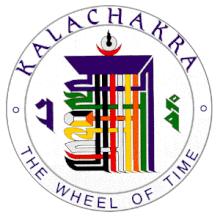Jonang
Jonangpa ( Tib .: jo nang ) refers to a sub-school of the Sakya tradition of Tibetan Buddhism ( Vajrayana ), which to a large extent - not least for political and historical reasons - has developed more like a completely independent order. The Sakya tradition is one of the four great Buddhist traditions ( Nyingma , Kagyu , Sakya and Gelug ) in Tibet .
Origin and teaching
The Jonangpa- Kalachakra - lineage goes Yumo Mikyö Dorje (Tib .: yu mo mi bskyod rdo rje , 11th century) a highly realized Siddha back and Kalachakra master. His son and principal disciple Dharmeshvara continued the line. Later (1294), Künpang Thugje Tsöndrü (Tib .: kun spangs thugs rje brtson 'grus ; 1243-1313), a descendant of the Yumo lineage, founded the Jonang Monastery , which became a main center for Kalachakra. Künpang Thugje Tsondrü's student named Dölpopa Sherab Gyeltshen (Dölpopa; 1292-1361) constituted the Jonangpa tradition with the decline of the political influence of the Sakya school in the 14th century to an independent school. He wrote the well-known text "Ocean of Clear Meaning" and a text on Shentong (Tib .: gzhan stong ), a teaching on emptiness ( Shunyata ). Dolpopa was known for his realization and learning, and gathered over 1,000 students who practiced his teachings. One of his students taught Tsongkhapa , the founder of the Gelug school, the various aspects of Kalachakra Tantra. The Jonang School was continued by Jonang Chogle Namgyel (Tib .: jo nang phyogs las rnam rgyal ; 1306-1386), a student of Dolpopas. The well-known master Jonang Taranatha (1575–1634) wrote an important basic work on the history of Buddhism in India and a unique work on the "five teachings of Maitreya ".
School decline
The Jonang School differed in its teachings from the other schools of Tibetan Buddhism because it interpreted the concept of emptiness differently. It existed in Tibet in the form of monastic communities well into the 17th century, when the fifth Dalai Lama Ngawang Lobsang Gyatsho had the school forbidden as heretical because of its divergent view . However, political and religious-political motives may also play a role in these events. He converted the Jonangpa monasteries in the central provinces into Gelugpa monasteries. A few Jonang monasteries in the eastern provinces were spared this interference because they were outside the control of the Gelugpa administration of Lhasa. Especially in southern Amdo and northern Gyarong - in today's districts of Dzamthang , Ngawa (Sichuan) and Pema (Qinghai), the tradition has survived to the present day and was able to expand its presence to 40 monasteries in this region. They continue the tradition of Kalachakra practice.
See also
literature
- Sheehy, Michael R. (2007): A Brief history of the Jonang Tradition (PDF; 115 kB) - www.jonangfoundation.org
- Gruschke, Andreas (2002), "The Jonang Order: Reasons for its decline, prerequisites for survival and the current situation", in: Henk Blezer (ed.), Tibet, Past and Present. Tibetan Studies I (Proceedings of the Ninth Seminar of The IATS, 2000), Brill Academic Publishers, Leiden 2002, pp. 183-214.
- Gruschke, Andreas (2001): "Monasteries of the forgotten Jonangpa". In: The Cultural Monuments of Tibet's Outer Provinces: Amdo , Vol. 2, White Lotus Press, Bangkok 2001, pp. 71-80. ISBN 974-7534-90-8
- Stearns, Cyrus (1999). The Buddha from Dolpo: A Study of the Life and Thought of the Tibetan Master Dolpopa Sherab Gyaltsen . State University of New York Press. ISBN 0-7914-4191-1 (hc); ISBN 0-7914-4192-X (pbk)

